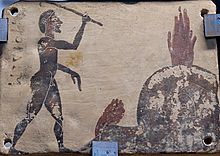Pinakes by Penteskouphia
The Pinakes of Penteskouphia ( Modern Greek Πίνακες από τα Πεντεσκούφια or Πλακίδια από τα Πεντεσκούφια ) are ancient Greek clay tablets ( Pinakes ), which on the northern slope of the mountain Kastraki below the castle Penteskouphi south of Corinth were discovered.
discovery
A farmer from the village of Penteskouphia discovered over 1000 fragments of ancient clay tablets about 900 m northwest of Penteskouphi Castle during robbery excavations in 1879. These came into the antique trade via Corinth and Athens . Sixteen of these panels were bought by the Louvre in Paris, all the others went to the Antiquarium in Berlin . There was also interest in finding out more about the location, but a short time later the location was greatly changed by a storm and so it was no longer possible for the farmer to give the exact location of the pinakes. Arthur Milchhoefer , who wanted to investigate the details of the find, traveled to Corinth the following year. He identified a slope of a stream as the site and came to the conclusion that the Pinakes had originally been located in a narrow space. There were few other finds and no architectural fragments were found in the vicinity. Milchhoefer suspected that the site was a waste dump at a Poseidon shrine, as the tablets were probably already broken when they were deposited there.
In 1905, Oliver Miles Washburn conducted search excavations for the American School of Classical Studies at Athens and discovered another 350 fragments of clay tablets. Most, however, were too badly weathered and therefore worthless for further investigation. Other finds were Proto-Corinthian and Early Corinthian pottery shards. These finds are now in the Corinth Archaeological Museum . However, it could be shown that some new fragments matched fragments that had already been found and so one was sure that either the original location of the Pinkakes or the dump where the farmer had disposed of fragments of poor quality had been found.
description
The pinakes from Penteskouphia are rectangular, on average about 10 cm high, 14 cm wide and 0.5 cm thick and painted on one or both sides. Usually the god Poseidon is depicted. They have one or more holes that they could be hung from in temples or on trees. Therefore, it is assumed that these are votive offerings to Poseidon and Amphitrite from a temple or a sacred grove of these deities.
Poseidon is depicted on 20% of the Pinkaes, on 18% human figures, on 11% chariots and horses, on 9% other animals, on 7% potters, on 4% other craftsmen and mythical scenes and on 2% ships. However, the majority of 29% is so poorly preserved that an assignment is not possible.
About 1030 of the 1200 or so fragments are decorated in the black-figure style . The painting is usually of high quality. However, the decoration is quite simple on some. Some pinakes date from the second half of the 7th century BC. BC, but most of it dates to the 6th century BC. Chr.
Some pinakes are inscribed with letters from the Corinthian alphabet from the 6th century BC. For example, the vase painters Milonidas and Timonidas , the woodcutter Onymon and the potter Sordis have immortalized themselves as donors.
literature
- Adolf Furtwängler : Description of the vase collection in the Antiquarium . Berlin 1885, Volume 1, No. 347-955 ( digitized version ). Volume 2, No. 3920-3924 ( digitized version ).
- Max Fränkel : Clay tablets from Corinth in the Berlin Museum in Ancient Monuments , Volume 1, Berlin 1891, pp. 3–4, panels 7–8 ( digitized version ).
- Clay tablets from Corinth in the antiquarium of the Royal Museums in Berlin in Ancient Monuments , Volume 2, Berlin 1908, p. 8 panels 23–24. 29-30. 39-40 ( digitized version ).
- HA Geagan: Mythological themes on the plaques from Penteskouphia . In: Archäologischer Anzeiger 1970, pp. 31–48.
- Ronald S. Stroud : Penteskouphia, Corinthia, Greece . In: Richard Stillwell et al. a. (Ed.): The Princeton Encyclopedia of Classical Sites. Princeton University Press, Princeton NJ 1976, ISBN 0-691-03542-3 .
- Maria Grazia Palmieri: Penteskouphia. Immagini e parole dipinte sui 'pinakes' corinzi dedicati a Poseidon (= Tripodes 15). Scuola Archeologica Italiana di Atene, Athens 2016. ISBN 978-960-9559-06-5 .
- Eleni Hasaki, Yannis Nakas: Ship iconography on the Penteskouphia pinakes from Archaic Corinth (Greece). Pottery industry and maritime trade. In: Jerzy Gawronski, André van Holk, Joost Schokkenbroek (eds.): Ships and maritime landscapes. Proceedings of the 13th International Symposium on Boat and Ship Archeology . Eelde 2017, ISBN 978-94-92444-14-1 , pp. 66-72 ( digitized version ).
- Eleni Hasaki: Potters at Work in Ancient Corinth: Industry, Religion, and the Penteskouphia Pinakes (= Hesperia Supplement 51). American School of Classical Studies at Athens, Princeton 2020, ISBN 978-0-87661-553-9 .
Web links
- The Pinakes by Penteskouphia in the Louvre
- museum-digital: state museums in berlin: Penteskouphia
- Corinth Monument: Penteskouphia
Remarks
- ↑ Maxime Collignon : Tablettes votives de terre cuite peinte trouvées a Corinthe in Monuments grecs publiés par l'Association pour l'encouragement des études grecques en France , Volume 12, 1897, pp 23-32 ( digitized ).
- ↑ Iakovos Ch. Dragatsis: Πινάκια Κορινθιακά in Παρνασσός. Σύγγραμμα Περιοδικόν κατά μήνα εκδιδόμενον Volume 5, Athens 1881, pp. 134-139 ( digitized version ).
- ↑ Adolf Furtwängler : Description of the vase collection in the Antiquarium. Volume 1, Berlin 1885, p. 47 ( digitized version ); Arthur Milchhoefer in: Archäologische Zeitung Volume 38, 1880, p. 195 ( digitized version ).
- ↑ Oliver Miles Washburn: Excavations at Corinth in 1905 . In: American Journal of Archeology Volume 10, 1906, pp. 19-20 ( digitized version ).
- ^ John Boardman : Early Greek Vase Painting . London 1998, p. 185.
- ↑ Olivier Rayet: Plaques Votives en terre cuite: trouvées a Corinthe. In: Gazette archéologique Volume 6, 1880, pp. 101-107 ( digitized version ).



